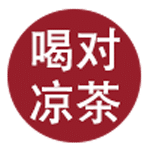What’s the Difference Between Throat Pain and Sore Throat? A Deep Dive into Cough, Pharyngitis, and Phlegm
From a Western Medical Perspective, coughing is a protective reflex that occurs when the respiratory tract is stimulated, aiming to clear foreign objects or secretions from the airways. It is not an independent disease but a common clinical manifestation of various respiratory system diseases. The causes of coughing are complex and diverse, including infectious factors such as the common cold, influenza, pneumonia, and tuberculosis, as well as allergic factors like allergic rhinitis and asthma.
From a Traditional Chinese Medicine (TCM) Perspective, oughing, pharyngitis, and phlegm production are all manifestations of an imbalance between the body's internal and external environments. The lungs govern respiration, control the body's Qi (vital energy), are connected to the skin and hair externally, and open into the nose. External factors like wind-cold, wind-heat, or dryness, or internal factors like emotional disturbances, improper diet, or overexertion, can lead to lung dysfunction, causing lung Qi to rise abnormally, resulting in coughing.
The throat is the gateway to the lungs and stomach and is closely related to the lungs. External pathogens invade the body, primarily affecting the throat, and internal heat can also injure the throat. Phlegm is caused by dysfunction of the lungs, spleen, kidneys, and other organs, leading to impaired fluid metabolism. The lungs are the storage organ for phlegm, the spleen is the source of phlegm production, and the kidneys are the root of qi reception. Dysfunction in these three organs leads to the internal production of phlegm, which accumulates in the lungs, flows down to the intestines, and spills over into the skin, affecting every part of the body.
Therefore, when treating coughing, pharyngitis, and phlegm, TCM does not simply focus on suppressing coughs, reducing inflammation, or eliminating phlegm. Instead, it emphasizes holistic regulation and treatment based on syndrome differentiation. For external conditions, it aims to dispel pathogens and promote lung function. For internal conditions, it regulates the internal organs, resolves phlegm and dampness, and clears deficiency heat. Simultaneously, TCM stresses dietary regulation, emotional well-being, and regular living habits to support healthy qi, eliminate pathogens, and fundamentally alleviate symptoms and restore health.

What’s the Difference Between Throat Pain and Sore Throat? A Deep Dive into Cough, Pharyngitis, and Phlegm
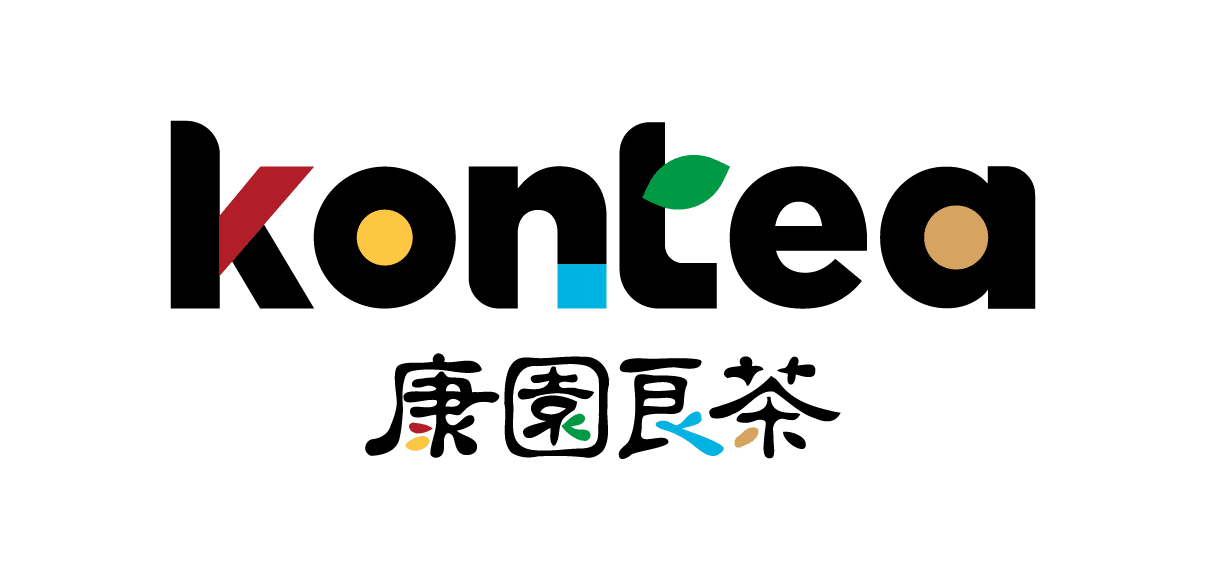
Understanding Coughs, Pharyngitis, and Phlegm
Our respiratory system is like a precise symphony orchestra, with each organ and tissue working in harmony to maintain our respiratory health. However, when external disturbances or internal imbalances disrupt this harmony, the respiratory tract plays a warning trio: coughs, pharyngitis, and phlegm.
Cough: The Respiratory Tract's Cleaner and Alarm
From a Traditional Chinese Medicine (TCM) perspective, the respiratory tract is a vital channel for gas exchange between the body and the external environment, and its health directly affects the circulation of qi (vital energy) throughout the body. Coughs, pharyngitis, and phlegm are three common warnings issued by the respiratory tract, reflecting not only local lesions in the respiratory tract but also potential imbalances in the body's qi, blood, yin, and yang.
Cough: An Alarm of Lung Qi Dysfunction
A cough is a manifestation of lung qi dysfunction.
- The Lung's Cleaner:
- TCM believes that the lungs govern qi and respiration, possessing the function of cleaning the respiratory tract. Coughs use strong airflow to expel external pathogens (such as wind-cold or wind-heat) or internally generated phlegm from the lungs, restoring the lung's dispersing and descending functions.
- A Signal of Organ Imbalance:
- The occurrence of coughs is not only related to the lungs but may also involve imbalances in other organs.
- For example, liver fire invading the lungs can cause coughs, and spleen deficiency with dampness can cause coughs with excessive phlegm.
- Different types of coughs have varying sounds, frequencies, and accompanying symptoms, reflecting different causes and mechanisms.
- A dry cough often indicates dryness injuring the lungs or yin deficiency with lung heat; a cough with excessive phlegm often indicates damp phlegm obstructing the lungs; and a cough that worsens at night often indicates lung yin deficiency.
Pharyngitis (Sore Throat): A Protest of Pathogenic Heat Accumulation
Pharyngitis is a manifestation of poor local qi and blood circulation in the throat, with pathogenic heat accumulating.
- Acute Pharyngitis:
- Often caused by external wind-heat or wind-cold pathogens, leading to poor local qi and blood circulation in the throat, pathogenic heat accumulation, and symptoms such as sore throat and difficulty swallowing.
- Chronic Pharyngitis:
- Often caused by lung and kidney yin deficiency with deficiency fire flaring up, or phlegm and blood stasis obstructing the throat, leading to symptoms such as dry throat, foreign body sensation, and hoarseness.
- TCM Regulation:
- TCM emphasizes treatment based on syndrome differentiation, using methods such as clearing heat and detoxifying, dispelling wind and dispersing cold, nourishing yin and moistening dryness, and resolving phlegm and nodules, based on the patient's constitution and symptoms.
Phlegm: A Barometer of Fluid Metabolism
Phlegm is a product of abnormal fluid metabolism in the body, and its color, texture, and odor serve as a barometer of fluid metabolism in the respiratory tract and throughout the body.
- A Manifestation of Fluid Imbalance:
- TCM believes that the lungs govern fluids, the spleen governs transportation and transformation, and the kidneys govern water. Phlegm production is closely related to dysfunction in the lungs, spleen, and kidneys.
- Phlegm Color and Pathogenesis:
- White or clear phlegm often indicates cold phlegm or damp phlegm; yellow or green phlegm often indicates heat phlegm or phlegm-heat accumulating in the lungs; pink or red phlegm often indicates lung network damage with blood; and black phlegm often indicates excessive cold dampness.
- TCM Phlegm Resolution:
- TCM phlegm resolution focuses not only on local treatment but also on overall regulation, fundamentally improving fluid metabolism through methods such as strengthening the spleen and resolving dampness, moistening the lungs and resolving phlegm, and warming and resolving cold phlegm.
Through the lens of TCM, we can gain a more comprehensive understanding of coughs, pharyngitis, and phlegm, thereby better maintaining respiratory health.
The Difference Between Pharyngalgia and Sore Throat
Many people often confuse the concepts of "pharyngalgia" and "sore throat" when they experience throat discomfort. Although both are related to pain in the throat area, they actually have some subtle differences in causes, symptoms, and affected areas.
- Different Locations: Pharyngalgia mainly refers to the tonsils and the posterior pharyngeal wall, while a sore throat includes the pharynx, larynx, and surrounding neck area.
- Symptom Differences: Pharyngalgia may be accompanied by fever and chills, while a sore throat may be accompanied by pain when swallowing.
- Causes: Pharyngalgia may be related to tonsillitis and pharyngitis, while a sore throat may be due to acute laryngitis, acute pharyngitis, and other conditions.
- Pain Location: Throat pain is mostly painful when swallowing, while sore throat pain is more often painful when speaking.
Symptoms of Pharyngitis
Symptoms of Pharyngitis: Warnings of Pathogenic Heat Accumulation and Qi and Blood Stagnation
Pharyngitis is the inflammation of the pharyngeal mucosa and surrounding lymphoid tissues. In Traditional Chinese Medicine (TCM), it is caused by external pathogen invasion, excess heat in the lung and stomach, or yin deficiency with exuberant fire, leading to stagnation of qi and blood in the throat. Its symptoms are diverse, including local discomfort and systemic reactions. TCM treatment of pharyngitis emphasizes syndrome differentiation, distinguishing between cold and heat, deficiency and excess, and adopting corresponding treatment methods based on the patient's specific symptoms and constitution.
External Wind-Heat: Heat Toxin Invades the Lungs, Throat Dysfunction
- Causes:Wind-heat pathogens invade the lung defense, and heat toxin accumulates in the throat.
- Symptoms:
- Red, swollen, and painful throat, especially aggravated during swallowing.
- Often accompanied by fever, headache, cough, and yellow phlegm.
- Red tongue with a thin yellow coating, and a floating and rapid pulse.
External Wind-Cold: Cold Pathogens Congeal, Meridian Dysfunction
- Causes:Wind-cold pathogens invade the body surface, and cold pathogens congeal in the throat.
- Symptoms:
- Slightly itchy and painful throat, with difficulty swallowing.
- Chills and fever, no sweating, nasal congestion with clear runny nose, cough with clear and thin phlegm.
- Pale red tongue with a thin white coating, and a floating and tight pulse.
Lung and Stomach Excess Heat: Heat Toxin Accumulates, Obstructs the Throat
- Causes:Accumulated heat in the lung and stomach, with heat toxin ascending to the throat.
- Symptoms:
- Severe red, swollen, and painful throat, dry throat, and thirst.
- Excessive yellow phlegm, constipation, and yellow urine.
- Red tongue with a yellow coating, and a surging and rapid pulse.
Lung and Kidney Yin Deficiency: Deficiency Fire Flaring Up, Throat Malnourishment
- Causes:Lung and kidney yin deficiency, with deficiency fire flaring up, and throat malnourishment.
- Symptoms:
- Slightly swollen throat, dry and burning discomfort, dry mouth and throat.
- Mild pain, or pain during swallowing.
- Scanty and sticky phlegm, worsening in the afternoon or at night.
- Red tongue with a scanty or slightly yellow coating, and a thin and rapid pulse.
TCM Syndrome Differentiation:
TCM classifies pharyngitis into various syndromes, such as wind-heat invading the throat, lung and stomach excess heat, and yin deficiency throat obstruction, each with distinct symptoms and treatment methods. Therefore, when pharyngitis symptoms occur, it is essential to seek medical attention promptly for syndrome differentiation and treatment to achieve optimal therapeutic effects.
Causes of Different Colors of Phlegm and How to Resolve Phlegm
Discomfort in the throat is often accompanied by phlegm, which can cause unpleasant sensations such as a foreign body sensation in the throat, coughing, and hoarseness. In Traditional Chinese Medicine (TCM) theory, phlegm is a pathological product of abnormal fluid metabolism in the body, often due to dysfunction of the lungs, spleen, and kidneys, leading to the inability of body fluids to be properly metabolized and thus accumulating into phlegm. Phlegm not only affects the respiratory tract but also obstructs the flow of qi (vital energy) in the body, causing various diseases. For example, phlegm obstructing the lungs can cause coughing and nasal congestion, while phlegm stagnating in the stomach can cause vomiting and gastric distension. Therefore, observing the color and texture of phlegm is an important basis for syndrome differentiation and treatment.
Causes of Different Colors and Textures of Phlegm
- Transparent Phlegm:
Cause: Mostly due to cold syndrome, caused by the congealing of cold dampness. - White Phlegm:
Cause: Can be seen in both cold and heat syndromes, requiring judgment based on specific conditions. - Yellow Phlegm:
Cause: Mostly due to heat syndrome, caused by heat pathogens accumulating in the lungs. - Green Phlegm:
Cause: Mostly due to heat toxin, caused by lung infection, and medical attention is recommended. - Phlegm with Blood Streaks:
Cause: Mostly due to yin deficiency or dryness-heat injuring the lungs, leading to lung network damage. - Foamy Phlegm:
Cause: often from wind pathogens attacking the lungs, requires assessment of the specific situation. - Large Amount of Thin Phlegm:
Cause: Mostly due to damp phlegm, caused by spleen deficiency with dampness. - Thick Phlegm:
Cause: Mostly due to dryness-heat or yin deficiency, caused by the depletion of body fluids.
Kang Won TCM Practitioner Guides You in Understanding How to Address Various Symptoms and Care Plans
Effective Ways to Relieve Throat Discomfort:
- Relieving Sore Throat:
- Medication Relief: Oral pain relievers such as acetaminophen or ibuprofen can alleviate pain.
- Alternating Cold and Warm Compresses: Cold foods like ice cream can temporarily numb the throat and relieve pain; warm liquids and foods like warm water, tea, chicken soup, and porridge are more tolerable.
- Soothing Foods: Honey and throat lozenges can relieve dry and painful throats.
- Drink Plenty of Water: Keep the throat mucous membranes moist, dilute phlegm, and facilitate expectoration.
- Improve Environment: Use a humidifier to maintain air humidity and avoid air pollution.
- Resolving Phlegm and Relieving Coughs:
- Drink Plenty of Water: Dilute phlegm and promote expectoration.
- Dietary Remedies:
- Tangerine Peel Water: Warms and resolves cold phlegm.
- Monk Fruit Chrysanthemum Tea: Clears heat and resolves phlegm.
- Snow Pear Cogongrass Root Drink: Nourishes yin, moistens the lungs, clears heat, and resolves phlegm.
- Tangerine peel, Coix seed, and lean pork soup: Strengthens the spleen and resolves dampness, suitable for damp phlegm.
- Maintain Respiratory Tract Moisture: Use a humidifier or steam inhalation.
Daily Care and Dietary Restrictions:
- Eat a light diet, avoid raw, cold, spicy, and fried foods.
- Avoid high-sugar beverages.
- Keep warm, avoid smoke and dust, and quit smoking and alcohol.
- Engage in moderate exercise to enhance physical fitness.
- Seek medical attention promptly for persistent coughs.
Kontea Recommendation Products
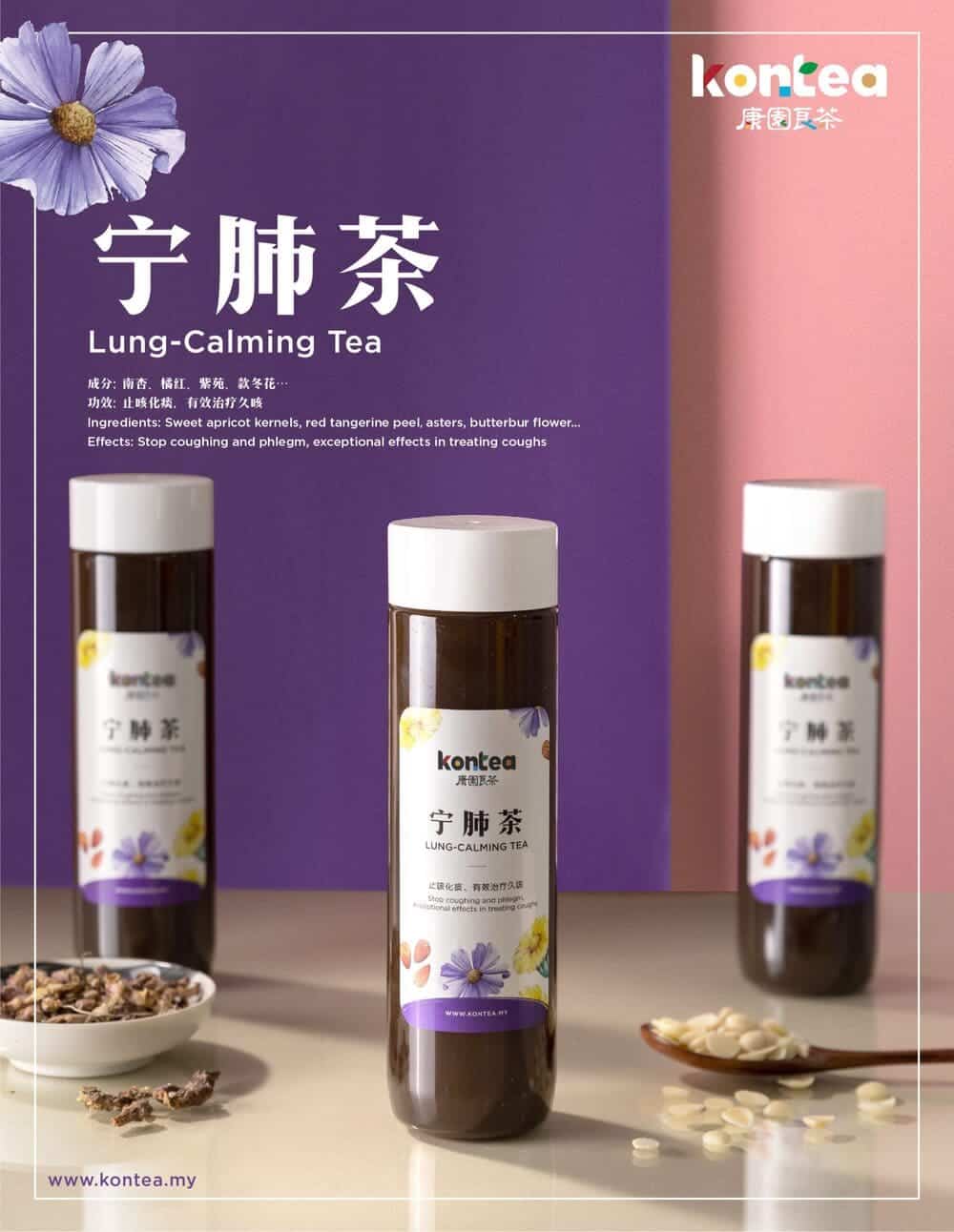
Lung-Calming Tea
Effects:Specially made by KangWon, the Lung-Calming Tea consists of sweet apricot kernels for its sweetness; red tangerine peel and asters for their effects of clearing the throat; and butterbur flower for its exceptional effects in treating coughs.
Suitable for:When coughing with a lot of phlegm.
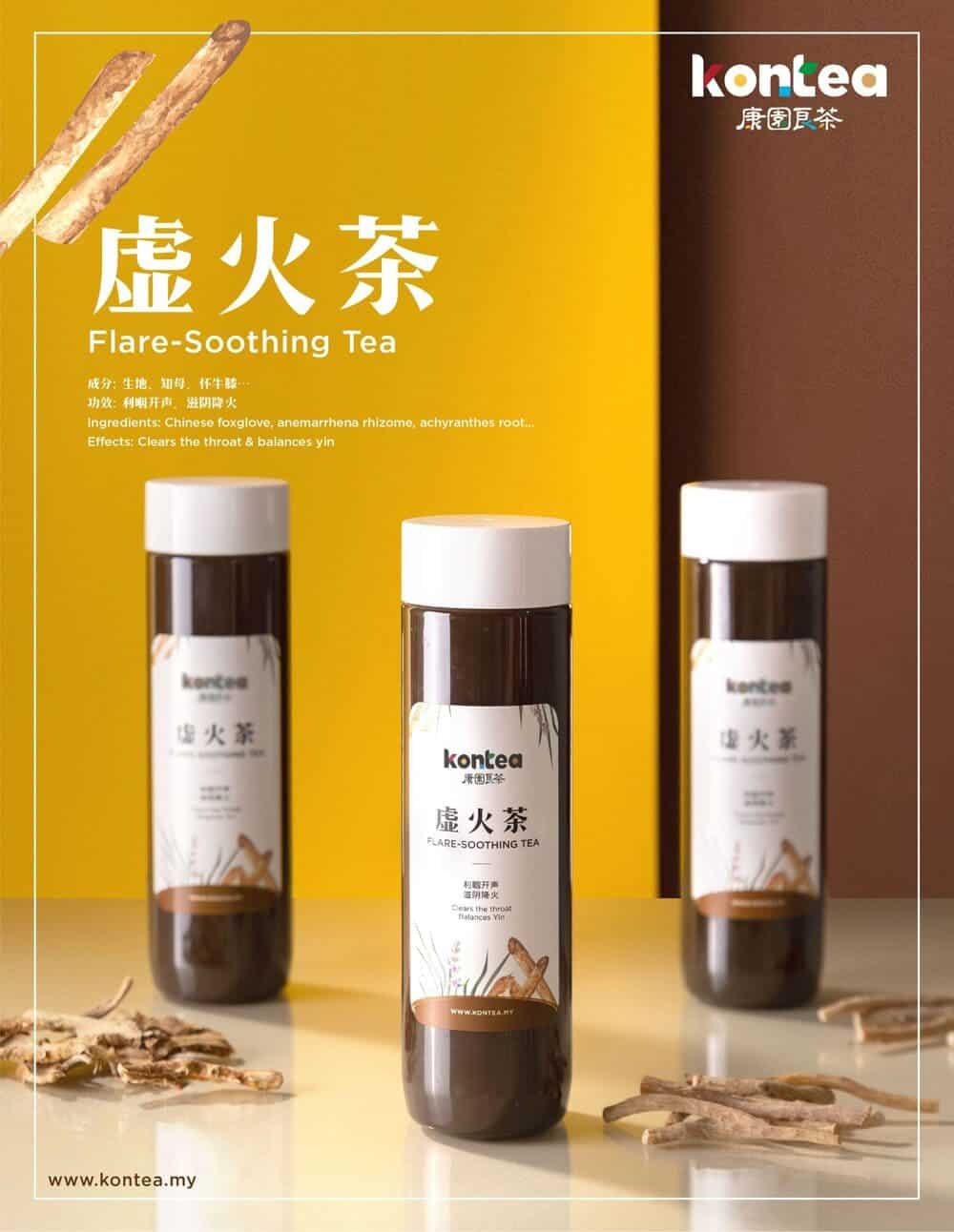
Flare-Soothing Tea
Effects:Asthenic fire refers to the flaring of excessive body heat due to weak body. Some symptoms include a dry and painful throat, distress, sweating before or during sleep, heat in the palms and feet, etc. The Flare-Soothing Tea is made of Chinese foxglove, anemarrhena rhizome, and achyranthes root, all of which improves blood circulation, clears the throat, and balances yin.
Suitable for:Sore throats and swollen gums from working late nights.
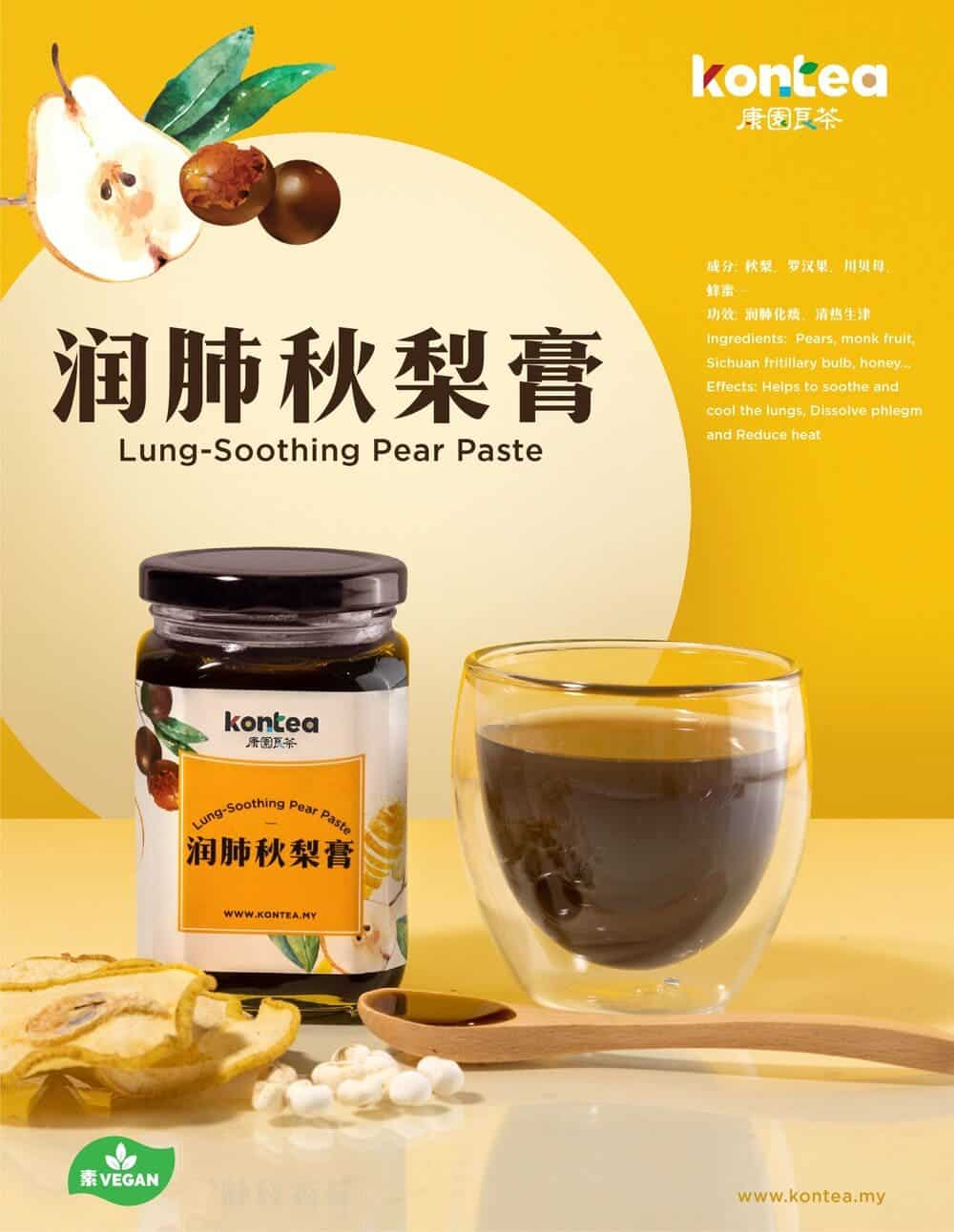
Lung-Soothing Pear Paste
Effects:A traditional medicinal diet since the Tang Dynasty. The main ingredient is pear; when stewed with monk fruit, Sichuan fritillary bulb, and honey, the paste helps to soothe and cool the lungs, as well as dissolve phlegm.
Suitable for:Dry throat and mouth; dry cough without phlegm; excessive body heat. Highly recommended for frequent drinkers and smokers.

Heat Cooler Paste
Effects:Reduces heat in a body lit by how frail it is.
Suitable for:People who work late, has painful and swollen gums.
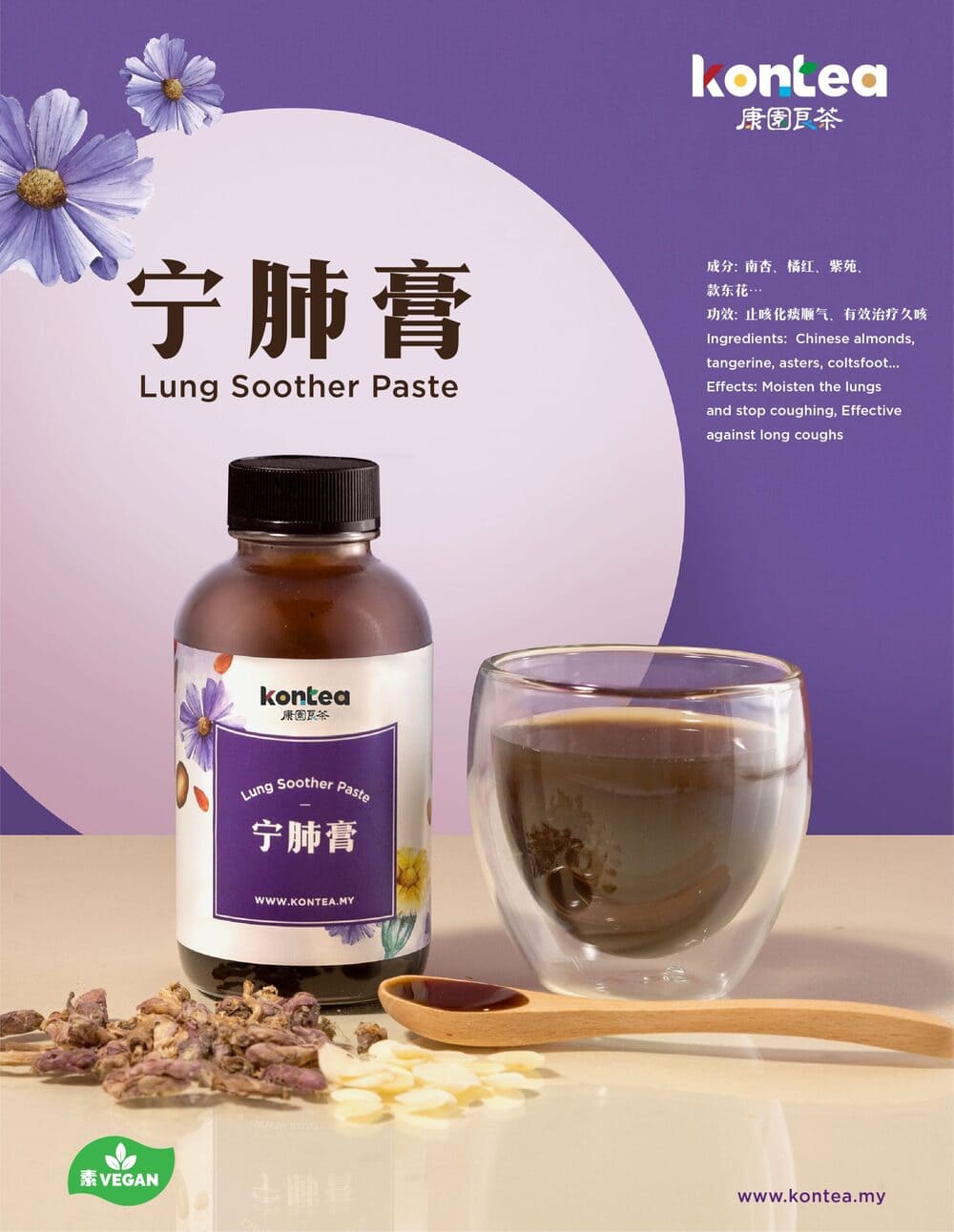
Lung Soother Paste
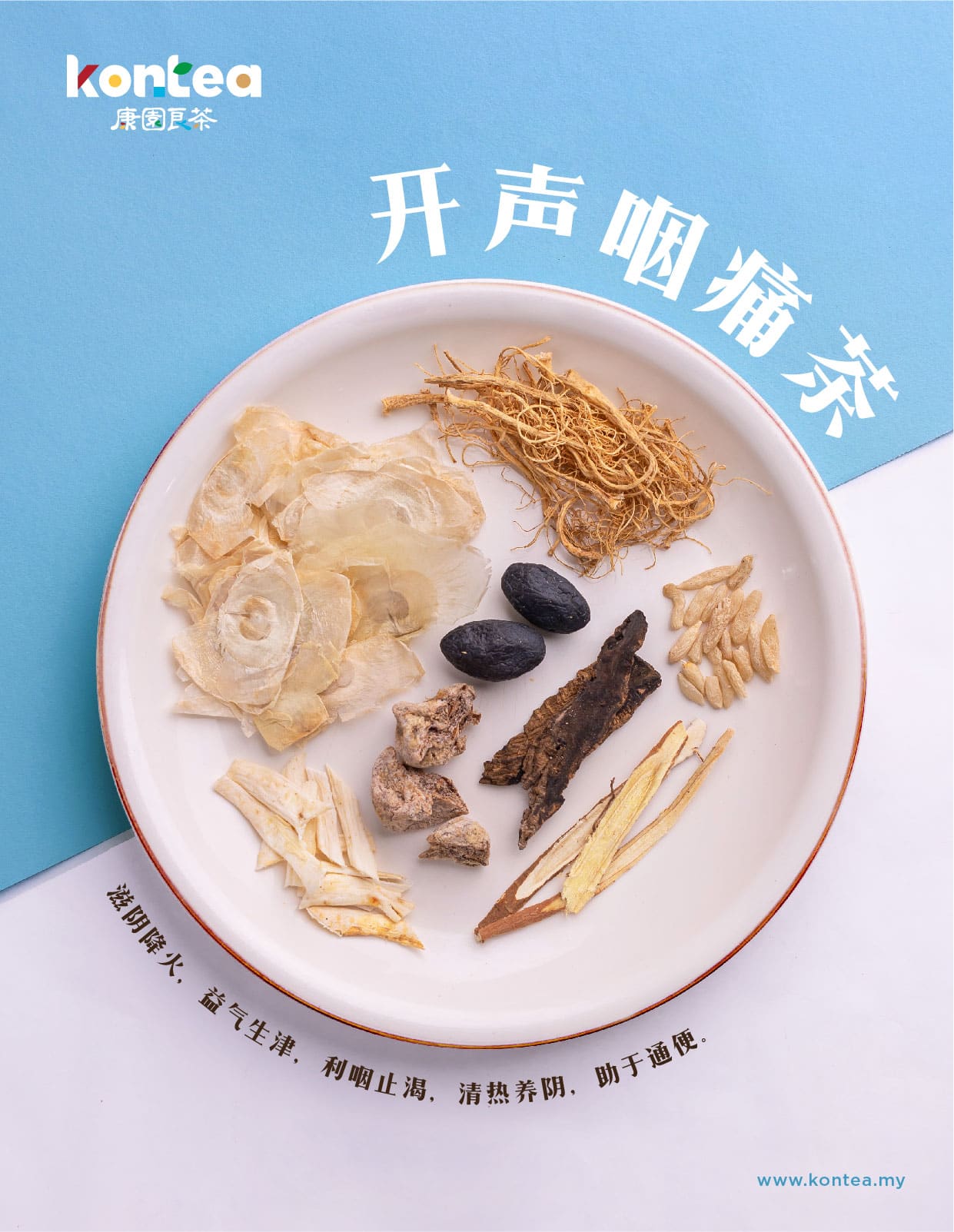
Throat-Clearing Tea
Effects:Ginseng root is good for nourishment and the invigoration of Qi. Chinese olive can relieve sore throat and thirst; Licorice with Platycodon can soothe the throat and the lungs. Ophiopogon with Scrophulariaceae can relieve the throat by clearing away heat and nourishing Yin, and also help to relieve constipation.
Suitable for:People who have a sore and dry throat, hoarseness and dry stool.
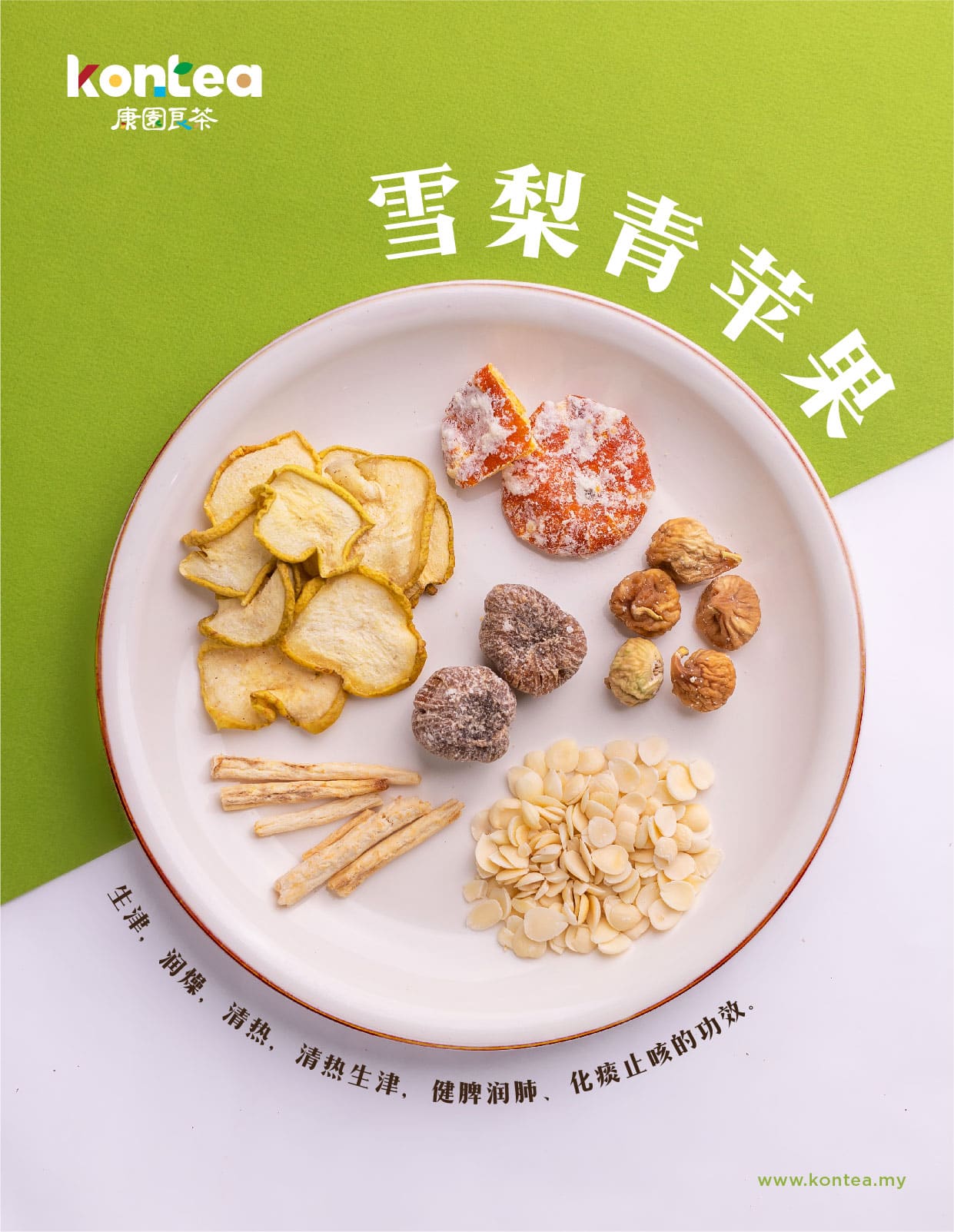
Snow Pear with Green Apple Tea
Effects:Dried snow pear has the effects of cooling properties and promotes the secretion of body fluid, moisturizing dryness and reducing phlegm. Ladybells and Figs which able to nourish the lungs and soothe inflammation. Candied Tangerine is a natural food processed from tangerines with orange peels, and it has the effects of invigorating the spleen, moisturizing the lungs and relieving cough.
Suitable for: People who have dry mouth and thirst, dry throat and cough.
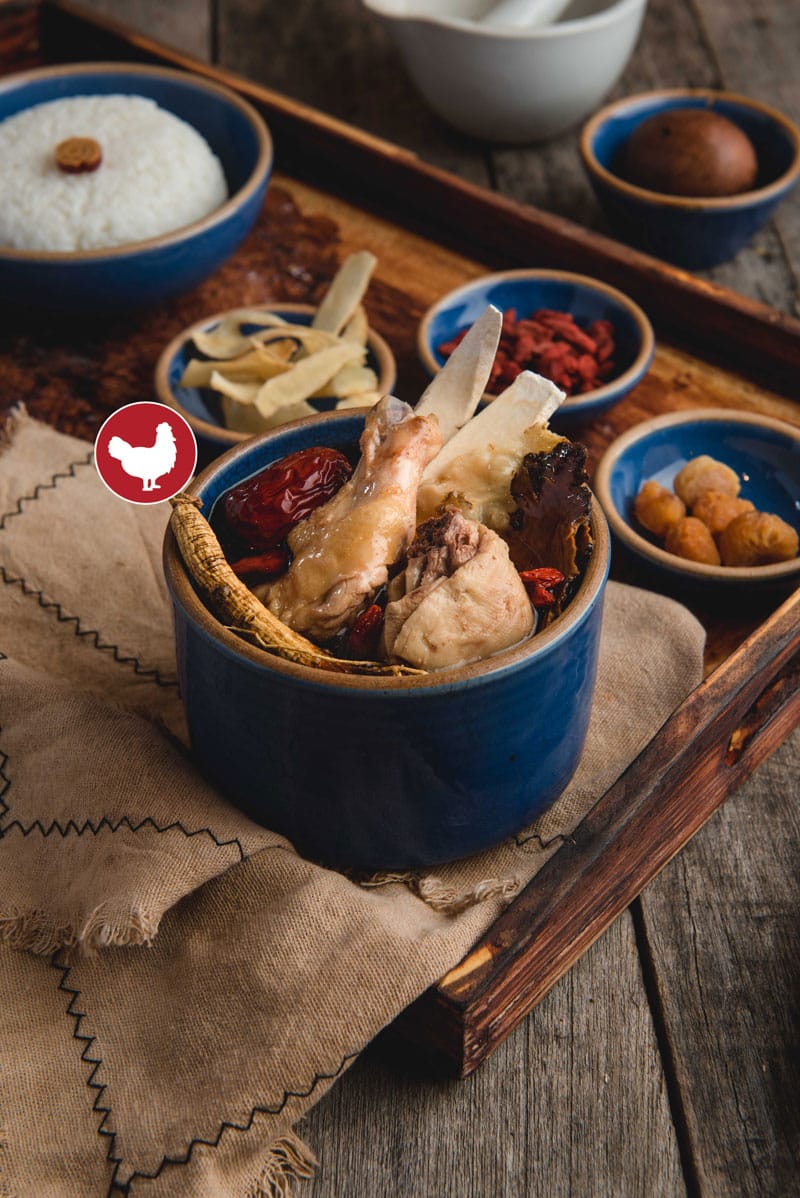
Fig & Cordyceps Soup
Effects:There are countless causes of sore throats, and most of it stems from bacteria. Figs are sweet and cooling, clears heat, removes toxins and reduces swelling. It can be used to soothe the throat and the lungs, and contains gallic acid, chlorogenic acid, and syringic acid, which are great for fighting bacterial diseases. Other than that, cordyceps flower can strengthen immunity when breathing, stop coughs, prevent against inflammation, and lowers cholesterol.
Suitable for:Dryness in the mouth and tongue, heat, people who stay up late, and frequents smokers and drinkers.
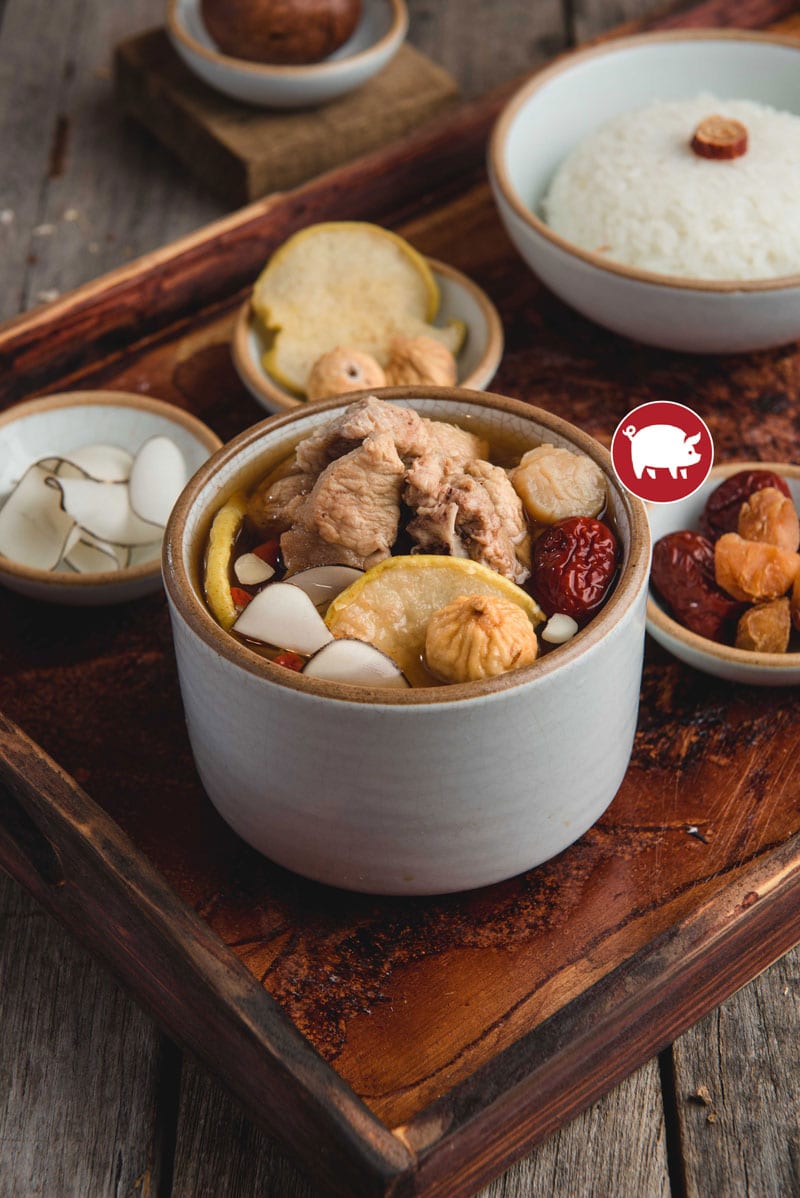
Sea Coconut Soup
Effects:Sea coconut highly benefits the lungs and throat. It strengthens the lungs to treat dryness which results in chronic cough. Through strengthening the lungs, it can also reduce phlegm. Paired with a fig, the soup also benefits the spleen, digestive system and relaxes the bowel
Suitable for: Cough, sore throat, phlegm, dry throat.
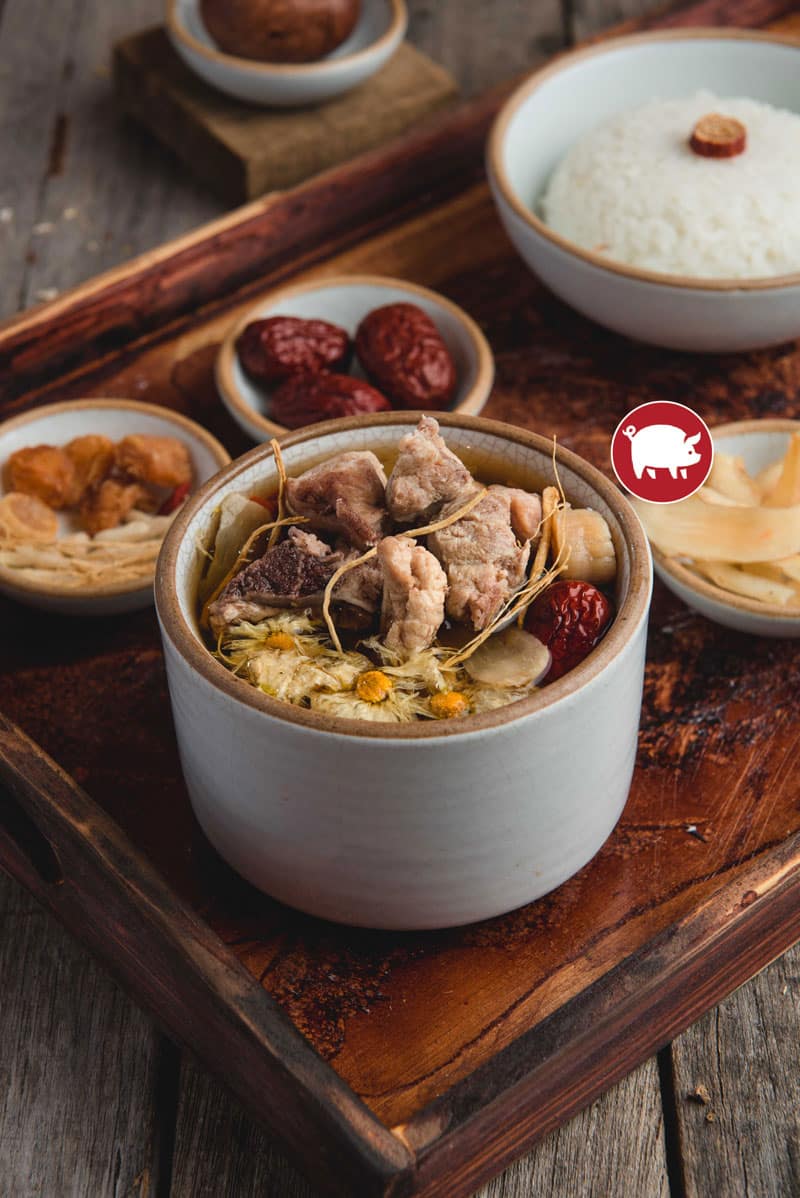
Ginseng Root Soup
Effects:Ginseng root has cooling properties and promotes the secretion of body fluid. Combined with mondo grass, which nourishes the lungs and relieves coughing and phlegm, as well as heat-relieving chrysanthemum, this soup is the ultimate heat-soothing medicinal food.
Suitable for:People suffering from heat. It can also soothe core throat, pain and swelling in the head, as well as dryness in the mouth.
Kang Won Herbalist
Kang Won TCM Practitioner also recommends seeking medical attention as soon as rheumatic symptoms begin to appear. Early consultation allows us to provide you with suitable treatment and prevention plans based on your symptoms and underlying causes.
Our TCM Practitioner specializes in diagnosing and treating various internal health issues in the internal medicine field. We are dedicated to balancing the body's energy flow to alleviate internal problems and improve overall health. Therefore, if you have any concerns about rheumatic diseases, we welcome you to consult with us in person to learn more.
Feel The Teaference
Kontea Products
Professional Service
TCM Services
Graduated from Nanjing University of Chinese Medicine in China, we are licensed Chinese medicine practitioners who provides professional Chinese medicine services. We approach each patient's case from their perspective, attentively listening and analyzing their physical condition.
